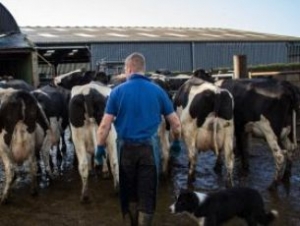Dairy farming

According to a new research report from CoBank, despite a 30 per cent reduction in milk prices since 2015, global milk production has continued to rise, with much of the surplus milk ending up as powder.
This excess volume of powder, along with large inventories in the US and New Zealand, has kept world milk powder prices low, with little hope of a meaningful recovery until at least 2017.
“US exporters will be up against robust competition and further challenged by a relatively strong US dollar,” said Ben Laine, a senior economist with CoBank’s Knowledge Exchange Division. “Recovery could be slow as European Union stocks are returned to the market.”
However, in the face of this supply buildup and flagging prices, new projects are in the works that could add an estimated 440 million pounds per year of additional powder manufacturing capacity in the US over the next two years.
“While this expansion may appear to be ill-timed in the current market environment, the longer-term outlook paints a much different picture,” explained Mr Laine. “In the long run, emerging markets and a growing world population will enable US dairy producers and processors to expand, especially if our powder industry competitively positions itself.”
The world population is expected to grow by more than 1 billion people by 2030 with most of that growth expected to occur in Africa and Asia - regions that are not particularly hospitable areas for milk production.
The economic conditions in these areas, however, are favourable for the consumption of dairy - a relatively inexpensive way to incorporate high-quality proteins into a diet.
It is expected that an additional 145 billion pounds of milk will need to be sourced in these regions by 2020, with an even bigger increase required over the subsequent 20 years, notes the report.
US producers have recognised this opportunity and are striving to become the suppliers of choice for milk powders in today’s global marketplace.
In fact, nine US manufacturers, representing more than half of the country’s skim milk powder (SMP) production, have recently invested in or are currently investing in the ability to increase production while meeting the rigorous specifications put forth by global customers, according to the report.
To bolster their competitiveness in world markets, US powder manufacturers will need to tailor and calibrate their output to meet global preferences and requirements. New and upgraded facilities must be increasingly flexible and able to shift production between SMP, nonfat dry milk and whole milk powder.
The new facilities also tend to be massive in processing capacity in order to realise larger economies of scale, thus lowering unit costs. Additionally, the ability to manufacture other milk-based ingredients such as lactose, casein, milk protein isolate, milk protein concentrate and others can diversify product offerings and improve margins.
“Dairy processors will need to be able to respond to shifts in the dynamics of component values and manufacture the most economically favourable product mix at the time,” noted Mr Laine.
How Does China - the Leading Importer of WMP - Fit?
Demand from China is significant, but sporadic. It will remain an important player in international trade of dairy products, but will also contribute to market volatility. About three quarters of China’s imports come from the EU, and most of the rest is sourced from New Zealand.
China’s imports surged in 2013 and 2014 and were a key contributor to the rise in both global and US milk prices. China’s dairy imports then pulled back dramatically amidst news of its slowing economic growth.
Slower economic growth will slow the growth trajectory for dairy needs in China, but it will not bring it to a halt. The easing of the one-child policy put in place in 1979 could increase the demand for infant formula by around 15 per cent over the next few years.
Also, lingering concerns about the quality and safety of Chinese-made infant formula following the melamine scandal of 2008 will support the demand for formula imports. In response to Chinese consumers’ preference for imported formulas, some Chinese formula companies have begun investing in farmland and building dairy plants in New Zealand and Australia.























